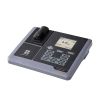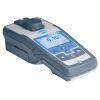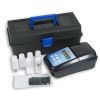Hach TL23 Series Benchtop Turbidimeters
Features
- Large full color display with guided procedures for calibration and verification
- Instrument detects sample stability prior to taking a reading
- USB port for data export, sample identification for traceability and self-diagnosis for quality assurance
- Free ground shipping
- Expedited repair and warranty service
- Lifetime technical support
- More
Overview
The Hach TL23 Series laboratory turbidimeters blend trusted technology of the 2100N/AN and improved features to simplify testing in the most demanding industrial and wastewater applications. With their ratio technology, the TL23 lab turbidimeters are ideal for industrial and other samples with a wide range of turbidity. The TL23’s ratio technology helps to overcome the interference from large particles and color when measuring turbidity.
Four Types of Models
- TL2300 (EPA, up to 4,000 NTU)
- TL2310 (ISO, up to 1,000 NTU)
- TL2350 (EPA, up to 10,000 NTU)
- TL2360 (ISO, up to 10,000 NTU)
TL2300 and TL2350 Turbidimeters
The optical system is comprised of a tungsten-filament lamp, lenses and apertures to focus the light, a 90° detector, a forward-scatter light detector, a backscatter detector (TL2350 only) and a transmitted-light detector. The instrument permits turbidity measurements at less than 40 NTU to be performed using only the 90° scattered-light detector or from 4000 NTU (TL2300) to 10000 NTU (TL2350) using the complete set of detectors (Ratio Measurement). With the Ratio Measurement on, the instrument’s microprocessor uses a mathematical calculation to ratio signals from each detector.
TL2310 Turbidimeter
The optical system includes an 860 ±30 nm light emitting diode (LED) assembly and a 90° detector to monitor scattered light. The instrument measures turbidity up to 1000 FNU or NTU using the single 90° detector. The instrument does not utilize ratio measurements.
TL2360 Turbidimeter
The optical system includes an 860 ±30 nm light emitting diode (LED) assembly and a 90° detector to monitor scattered light, a forward-scatter light detector, a transmitted-light detector and a back-scatter light detector. The instrument measures turbidity up to 1000 units in FNU measurement mode using the ratio detectors. Attenuation measurements of up to 10000 FAU units can be made using a single transmitted detector. The instrument measures turbidity at less than 1000 NTU using only the 90° scattered-light detector or up to 10000 NTU using the complete set of detectors (ratio mode).
- TL23 Series Turbidimeter
- Silicone oil
- Oiling cloth
- USEPA filter assembly
- 1-inch sample cells (30 mL) with caps (6x)
- Gelex secondary turbidity standardization kit
- StablCal calibration kit
- Power supply
- Power cord
- Dust cover
In The News
Monitoring Mariculture in the Gulf of Alaska
The mariculture industry in the Gulf of Alaska has been steadily growing in recent years, guided by ongoing research to help refine farm location and cultivation practices. A subset of aquaculture, mariculture focuses on rearing organisms in the open ocean. In Alaska, finfish farming is illegal, so most farms cultivate kelp, oysters, or a combination of the two. These small, locally operated farms started popping up in the Gulf of Alaska in the early 1990s, when shellfish farming first became legal. Kelp farming did not begin to catch on in the state until 2016. Many of the coastal areas that have grown interested in mariculture are historically commercial fishing communities.
Read MoreSupplying Seattle’s Drinking Water: Using Data Buoys to Monitor the Cedar River Municipal Watershed
Providing clean, safe, and reliable drinking water for the 1.6 million people in the greater Seattle area is a top priority for Seattle Public Utilities (SPU). With limited water supplies, SPU dedicates considerable resources to maintain its watersheds and mountain reservoirs. About 70 percent of Seattle Water comes from the Cedar River Municipal Watershed , and the other 30 percent comes from the South Fork Tolt River Watershed . [caption id="attachment_39574" align="alignnone" width="940"] Data buoy in Chester Morse Lake . (Credit: Kevin Johnson / Seattle Public Utilities) [/caption] Jamie Thompson, a fisheries biologist at SPU, monitors aquatic ecosystems centered on fish listed under the U.S. Endangered Species Act (ESA).
Read MoreData-Driven Advocacy on the Lower Deschutes River
Like many freshwater environments, the Deschutes River in Oregon is under pressure from development, pollution, and climate change. Many rivers, streams and lakes in the Deschutes Basin do not meet Oregon water quality standards –where state water quality monitoring assesses levels of bacteria, pH, dissolved oxygen, temperature, and fine sediment. Hannah Camel is the Water Quality Coordinator for the Deschutes River Alliance (DRA), a non-profit organization that focuses on the health of the lower 100 miles of the Deschutes River–the area most affected by human intervention. As a data-driven organization, the DRA has benefited from the installation of two NexSens X2 data loggers.
Read More














